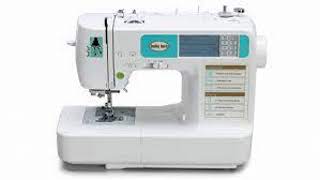Thanks to She’s A Sewing Machine Mechanic for the article and images.
If you’re getting frustrated with your machine, take a deep breath, and go Sewing Machine Is Serviced through the following list. (You can click on the images to make them bigger.)

1. When you see this on the back of your fabric, it usually means that the top thread hasn’t been threaded properly, and is probably not completely in the tension disks. Remember to lift the presser foot when you thread your machine. This will open the tension disks, so the thread can go inside them. Re-thread the top and bobbin threads. Be sure you are threading correctly.
2. Adjust your tensions. Set your upper tension at the “normal” setting. It is usually marked on the dial. If not, set it at 3. Thread the machine with a dark thread on top, and a light thread in the bobbin. Then sew with a medium zig-zag stitch.
3. Do you need to adjust your bobbin case tension? Remember, “righty-tighty, lefty-loosey.”

Here are some pictures of bobbin cases. Your drop-in bobbin also has a bobbin case, that you can adjust the tension on. They are the plastic ones on the right.

The top thread should be just a “tick” on the back of the fabric. (See the “Sewing Machines Tensions” page for more details.)

4. Replace the needle — it may be bent, have a broken tip, or a burr on it. Is the needle inserted in the right direction? Usually, the flat side on the top of the needle goes towards the back, but not always. Side-loading machines will be different, so check your machine’s manual on these. Is the needle pushed all the way up? If it’s skipping stitches, that’s the first thing to check. Is it the right needle for your machine? Most machines need a needle with the 130/705H configuration on the package. Schmetz and Bernina’s needles are interchangeable. Singer needles are not.
5. Clean and oil the bobbin and feed the dog area about every 2 to 4 hours of sewing time. Remove the bobbin, bobbin case, needle plate (and hook on an oscillating bobbin system). Use the lint brush to sweep out the lint, and put one drop of oil on the race or center hole under the bobbin case. Only use clear “sewing machine oil,” not 3-in-one or WD-40. Sew on a scrap of fabric to remove excess oil before sewing an important project. (See the “How To Clean and Oil the Bobbin Area” page for more details.)
6. Are you using a good-quality thread? It really does make a difference! If you want a quality stitch, use a quality thread. I recommend Metler or Guternam. Never use “hand quilting” thread on your machine.
7. Are the feed dogs up? Do you know where your feed dog switch is? Flip the switch, and rotate the handwheel one complete turn to bring them up. Please don’t try to force them up. On many machines, it just takes one rotation of the handwheel to bring them back up.

8. Is your bobbin winder switched on? If your machine is locked-up, and you can’t even turn the handwheel, it may be that your bobbin winder is on. Or if you press the foot control, and the machine makes a noise, but doesn’t sew, it may also be that your bobbin winder is on. Switch it off or tighten the clutch on the handwheel (on an older machine).
9. If your fabric isn’t feeding through the machine, check your presser foot tension, if your machine has one. This controls how tightly the fabric is squeezed between the presser foot and feed dogs. It is usually on the top, left of your machine. You can tell if it’s too loose by lifting and lowering the presser foot lever. You should feel some resistance. Tighten it if it’s too loose.

10. Is the bobbin in the bobbin case correctly? Put the bobbin in so the thread makes a “lazy S” as the thread is pulled into the slit. In other words, you don’t want the thread rolling off the bobbin and straight into the slit. You want the thread to turn back, then go into the slit. Usually, with oscillating or rotary hook systems, when you put your bobbin in the bobbin case and pull the thread, it should rotate clockwise. Drop-in bobbins will usually rotate counter-clockwise. Are you using the correct bobbin for your machine? Check the height and width. It should fit snuggly in the bobbin case, but not bind. And it shouldn’t be taller than the bobbin case (unless your machine is a Singer Featherweight). Make sure your bobbin isn’t wound loose or sloppy, and that there are no threads dangling out of the center or wrapped around the outside.

11. Check your stitch length. If your machine is “eating” your fabric, you may want to make the stitch length a little longer. Or if you’re starting on a pointed corner, sew on a scrap before feeding the corner under the needle.

12. If you’ve gone through the list, and you’re still not sewing well, you’ll probably need to take your machine to the shop. Your machine may just need a deep cleaning. Or, it’s possible that the timing is off. You’ll know this if the needle thread isn’t picking up the bobbin thread, or if the machine is skipping stitches. What causes the timing to go out is hitting a big pin, sewing over a really thick seam, or breaking a needle. Adjusting the timing is something only a trained professional should do.


